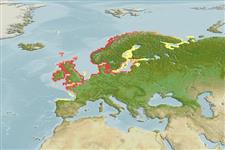Environment: milieu / climate zone / depth range / distribution range
Ecologia
marinhas; estuarina bentopelágico; não migratória; intervalo de profundidade 1 - 6 m (Ref. 130221). Temperate; 71°N - 43°N, 11°W - 55°E
Northeast Atlantic: north-western Europe.
Tamanho / Peso / Idade
Maturity: Lm ? range ? - ? cm
Max length : 22.0 cm SL macho/indeterminado; (Ref. 4119)
Espinhos dorsais (total) : 14 - 17. Front of body brassy-yellow in the male, with larger pectoral fins than in the female (Ref. 35388).
Adults live solitary or in pairs in weedy, shallow coastal areas (Ref. 4119). Feed on small invertebrates (Ref. 4119). Males build a nest from algae and debris, using kidney excrete as glue. Spawning season is May to June. Females deposit 150 - 200 eggs in the nest and often die shortly afterwards (Ref. 9900). Males care for and defend the nest. Offsprings reach maturity in one year (Ref. 4645).
Males build, guard and aerate the nest where the eggs are deposited (Ref. 205). Also Ref. 53335.
Muus, B.J. and P. Dahlström, 1974. Collins guide to the sea fishes of Britain and North-Western Europe. Collins, London, UK. 244 p. (Ref. 173)
Status na Lista Vermelha da UICN (Ref. 130435)
Ameaça para os humanos
Harmless
Uso pelos humanos
Pescarias: sem interesse
Ferramentas
Relatórios especiais
Baixar XML
Fontes da internet
Estimates based on models
Preferred temperature (Ref.
123201): 7.5 - 12.5, mean 9.9 °C (based on 512 cells).
Índice de diversidade filogenética (Ref.
82804): PD
50 = 1.0000 [Uniqueness, from 0.5 = low to 2.0 = high].
Bayesian length-weight: a=0.00468 (0.00205 - 0.01068), b=3.04 (2.83 - 3.25), in cm total length, based on LWR estimates for this (Sub)family-body shape (Ref.
93245).
Nível Trófico (Ref.
69278): 3.5 ±0.37 se; based on food items.
Resiliência (Ref.
120179): Elevada, tempo mínimo de duplicação da população menor que 15 meses (K=1.78; tm=1).
Fishing Vulnerability (Ref.
59153): Low vulnerability (17 of 100).
Nutrients (Ref.
124155): Calcium = 35 [8, 105] mg/100g; Iron = 0.37 [0.14, 1.25] mg/100g; Protein = 2.67 [0.00, 6.47] %; Omega3 = 0.522 [0.226, 1.292] g/100g; Selenium = 9.45 [1.54, 29.35] μg/100g; VitaminA = 19.8 [6.0, 61.4] μg/100g; Zinc = 0.842 [0.413, 1.601] mg/100g (wet weight);
